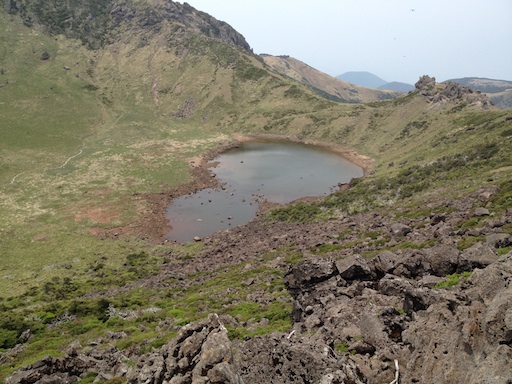As I wrote in my previous post I spent a week in Jeju Island and one of the things I did was climb Hallasan.
At 6,398 ft (1950 m), Mt. Halla is the second highest mountain on the Korean peninsula after Baekdusan and the highest mountain in South Korea (“san” means mountain in Korean).
In a way, the whole of Jeju-do is part of Hallasan as it grew outward from the now dormant volcano.
The night before the climb we went to E-Mart (sort of like a slightly more upscale version of Walmart) to pick up supplies. We got a few bottles of water, some dried persimmons, maki-sushi rolls, and a wide brimmed hat. For our main dish, we stopped by a local restaurant and picked up some bossam–boiled pork with lettuce and kimchi.
At 6:00 AM the next day we set out for adventure.
There are a few different ways up the mountain. We chose the Seongpanak Course, which runs about 9 and a half hours round trip up and down the mountain.
About half an hour into the hike we stopped for a snack break. A cheerful old man on his way back down the mountain piped out, “Oh, Hallasan will make you hungry,” as he passed us by.
About an hour into the hike a group of high school boys overtook us. Each one carrying a plastic orange sack in one hand with a boxed lunch from a convenience store.
A few minutes later, another group of students overtook us. And a few minutes later another… Before we knew it were in the thick of an endless stream of high school boys, all carrying identical orange bags.
It turns out that we were right in the middle of Graduation Trip season and several schools had brought their students to climb Hallasan that day. The Graduation Trip is a standard part of Korean K-12 schools. Unlike in America, these trips are organized by the school and the entire class is brought on a mandatory trip.
To that end, avoid visiting Korea the last couple weeks of May and the first couple weeks of June.
After 5 hours of huff and puff we arrived at the summit. The view from the summit is breathtakingly spectacular. When you look out you see the island stretching as far as the eye can see in every direction and it makes you appreciate just how large Jeju-do really is. Even the nearest towns look distant and tiny. Though on a very clear day I expect you could see the ocean off in the distance.
On the summit itself, there is a crater lake called Baeknokdam. The name is somewhat cryptically derived from Chinese characters and most Koreans don’t even know what it means. Being a Chinese character aficionado, I later looked it up and discovered it means “White Deer Lake.” We did see a few deer on our climb, so I presume it was named after them.
After finishing off our bossam and other goodies, we waded through yet more groups of students and started heading back down the mountain.
The thing about mountain hiking is that it isn’t the going up that gets you, it’s the going down. About 30 mins into the descent our knees were already aching. A couple hours in and our calves were exploding. By the time we reached the bottom of the mountain we were practically tumbling down it.
When we finally got back to the hotel that night we fell asleep as soon as we hit the pillows.
The next day our legs, especially our calves, were still excruciatingly sore. It was comical for my wife and I watching each other hobbling around like a couple of old folks, and knowing we were both feeling the same thing. The shared pain and experience made me feel close to her in a way I hadn’t quite felt before.
To alleviate our aches, we went to a foot and leg massage place. Ohhh man did it hurt so good. They masseuses pounded, rubbed, and poked sore muscles I didn’t even know existed.
Every time one of us yelled out in pain the masseuse would say, “bear with it, it’s because you went to Hallasan.”
Later on in the hotel, we replicated some of the maneuvers from the massage place on ourselves and discovered it took almost no effort to induce mind-numbing pain. At the time, we had thought the masseuses were pounding on us really hard to loosen the muscles up. In retrospect, they were probably laughing at us because of how little pressure it took to make us writhe and squirm.
It was a good week later before we could finally tackle a set of stairs without cringing in agony.
Climbing Mount Halla is definitely not recommended unless you have youth or a decent level of fitness on your side.
That said, if you can make it up and down her it’s well worth it both for the beauty of Hallasan and the feeling of accomplishment at conquering the mountain.

{ 0 comments… add one now }